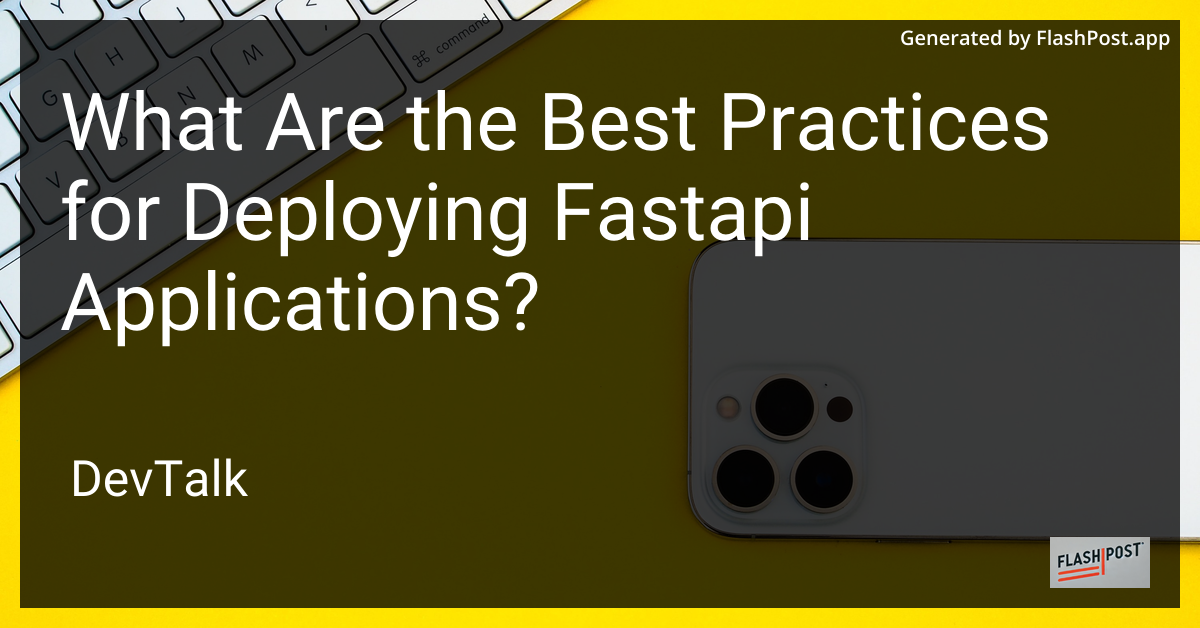What Are the Best Practices for Deploying Fastapi Applications?

Best Practices for Deploying FastAPI Applications
FastAPI has quickly gained popularity as a modern, fast (high-performance), web framework for building APIs with Python 3.
7+ based on standard Python type hints. However, deploying FastAPI applications can be daunting if not done with best practices in mind. Here's a comprehensive guide to ensure your FastAPI deployments are smooth and efficient.
1. Environment Configuration and Management
Use Virtual Environments
Always use a virtual environment to manage your dependencies. This ensures that your project is isolated and won't interfere with other projects. Tools like venv, virtualenv, or pipenv are excellent choices.
Environment Variables
Utilize environment variables for managing configuration settings like API keys, database URLs, and other secrets. You can use packages like python-decouple or python-dotenv to simplify handling configuration.
2. Server Configuration
Production-ready Server
Although FastAPI comes with an internal ASGI server, uvicorn, for development use, it's crucial to deploy with a production-level server. Consider using gunicorn with the uvicorn worker class for better performance and stability.
gunicorn -w 4 -k uvicorn.workers.UvicornWorker myapp:app
HTTPS
Always deploy your API with HTTPS to ensure that data is encrypted during transit. Consider using a service like Let's Encrypt for free SSL/TLS certificates.
3. Optimizing FastAPI Application
Asynchronous Code
FastAPI is designed to support asynchronous programming. Make the most of async and await to handle I/O operations without blocking, increasing your app's responsiveness and throughput. For more on this, visit our resource on Python Web Development.
Efficient Data Validation
Use Pydantic models for validation and parsing. This provides a standard way of defining the shape of your data and ensures that all incoming data is validated against your defined schemas.
Structuring Endpoints
For complex operations, consider breaking down routes into multiple endpoints with APIRouter. This approach promotes modular code organization and better maintainability.
4. Managing Static Files
Serve Static Files Efficiently
If your application needs to serve static files, make sure to configure a suitable server like Nginx or Apache to handle these requests separately from your FastAPI application.
5. Error Handling and Logging
Centralized Error Management
Implement global exception handlers in FastAPI to ensure that you manage errors gracefully and return meaningful error messages to the users.
Logging
Integrate logging throughout your application. Utilize Python's logging module to track useful information and errors, which significantly aids in monitoring and debugging in production.
6. Advanced Practices
Handling Complex Requests
In scenarios requiring the handling of complex request data, such as passing arrays or multi-part paths, ensure you are familiar with FastAPI’s capabilities. You can refer to our dedicated guides on array of strings, FastAPI Multi-part Path Tutorial, and more.
Troubleshooting Common Issues
Familiarize yourself with common issues and their fixes, like the 'No Attribute Routes' error in FastAPI, detailed in this troubleshooting guide.
Returning Media Content
If your application returns non-JSON responses, such as images, ensure you handle the response format correctly, such as returning an img element as described here.
By following these best practices, you can deploy FastAPI applications that are not only high-performing but also robust and secure. FastAPI's potential is immense, and leveraging these strategies will ensure you harness its full power effectively.